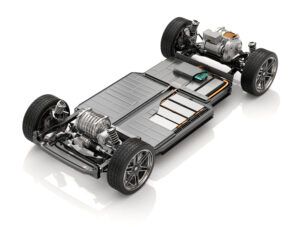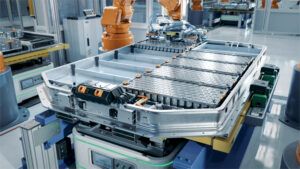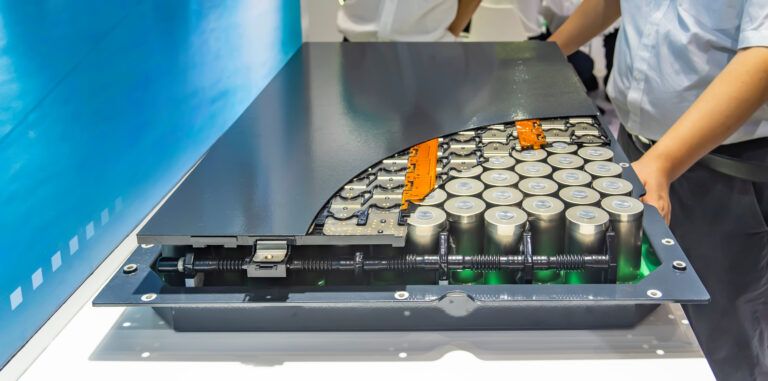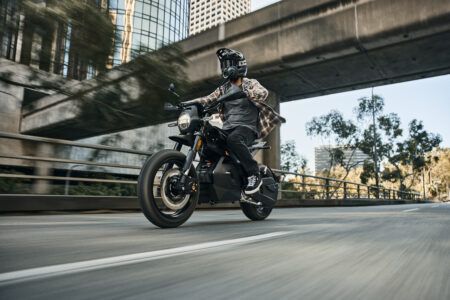The past decade, the electric vehicle industry has witnessed advancements in battery pack design influenced by innovative design trends. We explore the emerging trends shaping the future of EV batteries for both mass-market and niche vehicle applications.
The not-so-humble battery is approaching 225 years old. Over its lifetime, its architectures have come a very long way from its original uncomplicated design. From Alessandro Volta’s rudimentary breakthrough in 1801, which saw the world’s first battery consist of copper, cardboard, zinc, leather separators and, unbelievably, a conducting element that was his own tongue. Skip forward to 1979, and the crucial breakthrough of rechargeability for lithium-ion cell batteries, discovered by John B. Goodenough and Koichi Mizushima sent the battery market skyward.
Today, the global electric vehicle battery market is predicted to hit US$85.35bn in 2024 and is expected to reach around US$252bn by 2032. The automotive industry alone expects demand for lithium-ion cells to grow by 33% annually, reaching 4,700 GWh by the end of this decade.Despite those early limited capacity batteries, evolving design has opened the door for industry-changing technologies, particularly coming to fruition in the realm of electric mobility as engineers continue to create highly developed technologies.
The early days of EV battery design
Reflecting on the battery designs for BEVs from just a decade ago with the e-mobility market in its nascent stages, two prominent models made a big impact: the Nissan LEAF and the Tesla Roadster, each employing distinct battery technologies. These early designs were heavily influenced by battery technologies from other industries. For instance, Tesla utilized cylindrical cells like those in power tools, while Nissan adopted pouch cells, which were more commonly used in consumer electronics.
These initial designs were about assembling numerous small cells into a large battery pack, often involving complex cooling systems to manage heat and performance issues. These initial designs were about assembling numerous small cells into a large battery pack, often involving complex cooling systems to manage heat and performance issues.
Professor James Marco, an expert with two decades of experience in electrification who is head of the Energy Directorate at WMG at the University of Warwick and leads the Battery Systems Research Group, recalls these early designs.
“If you compare how battery systems have evolved when we started out, they were designed to be like a Russian doll,” he says. “It was a battery in a box, in a box, in a box. The battery cells were typically aggregated into modules, and then those modules became packs. This multi-layered approach resulted in significant overhead, leading to low energy and volumetric density. This method was done mainly for maintenance as we didn’t understand how to optimize the battery system at that time.”
The drawbacks of these early designs were evident. Some systems used air cooling, while others employed liquid cooling with numerous seals that often failed, leading to leaks. A notable example was the Chevrolet Bolt, which experienced frequent failures due to its cooling system. Tesla, despite using liquid cooling, had to go through several iterations to optimize its arrangement.
By the mid-2010s, the industry began to standardize around a few key design principles with a significant shift in battery design when prismatic and pouch cell formats were introduced. These formats were designed to improve energy density and packaging efficiency, which as Marco explains, “is not just about packing in as many cells as possible; it’s about being more efficient with the cells, making them larger but more energy dense.”
The progression of battery design has been less about singular breakthroughs and more about a gradual evolution driven by the availability of materials, equipment, and standardized approaches. Initially, manufacturers experimented with various technologies before narrowing down to a few viable solutions for mass production. The evolution has been relatively slow due to the readiness of suppliers at multiple levels.
“The battery industry has been on an incremental journey as a result of cost, risk, and uncertainty,” says Marco. “OEMs have been slowly evolving their innovation, but now the pace of change is accelerating.”
 Building for the masses
Building for the masses
With the global EV market manufacturing more than 750 GWh of cells in 2023 (up 40% from 2022), driving down cost is paramount. As the battery accounts for around 30% of the total vehicle cost, this key factor has been an influential force in how battery design has changed.
Early typical battery architecture took the form of a module-to-pack (MTP) setup, but new battery technology trends are moving towards a cell-to-pack (CTP) design, as well as batteries more intricately integrated into the vehicle’s structure in the form of cell-to-chassis (CTC) or cell-to-body (CTB) designs that optimize space, handling, and performance.
To achieve these new architectures, one of the biggest differences with modern designs is the reduced number of modules. Ten years ago, opening a battery pack would reveal many modules connected in series or parallel, typically designed under 60V for safety reasons. This design choice was driven by maintenance and manufacturing considerations. Modern battery packs, even if a pack uses a cell-to-module architecture, feature fewer but larger modules and cells.
As such, much larger physically, cylindrical cells are coming to market which brings the cost down per kilowatt. For prismatic cells, they are also increasing in size so that a battery only needs approximately 100-200 in a pack, rather than a several thousand.
The quest for higher energy density continues to drive innovation. New battery technologies, such as BYD’s Blade battery and Tesla’s tabless 4680 cells, are setting new standards. These standout examples of cell and pack design reduce internal resistance and improve thermal management, contributing to greater efficiency and safety.
“The Blade’s cell and pack design is just wonderfully simple,” says Marco. “Within its low-profile pack are slim rectangular modules, lying on a simple cold plate. The vent path, in the event of a failure, simply vents downwards, there’s no need for complex bus bars, there’s no need for complex routing of gases or ejected material. That’s how it manages to get the packing efficiency so high.”
The influence from this innovation is that leading automotive OEMs are now beginning to look at design and manufacture from the other direction – rather than taking a component and optimizing that component for a pack, they are focused on optimizing the cell itself.
“The majority of the large automotive organizations that we speak to are now actively involved in cell design,” says Marco. “They’re not specifically looking at the electrochemistry side; they’re looking at the mechanical structure of the cell, such as its size and shape, to increase packing density and improve efficiency and safety.”
According to Marco, the trend now is for manufacturers to no longer start from a small cylindrical battery, but rather aggregate up from an 18650 or a 217100.
Big demand for bespoke batteries
While the mass EV market is setting the pace, the low-to-medium-volume EV market is not to be left in its dust. From the electric two and three-wheeled automotive market to marine, industrial vehicle, eVTOL, and off-highway, which combined are larger than the mainstream automotive market. All these applications need battery solutions but for many manufacturers it’s not as simple as picking something off the shelf.
Raeon, a UK company that has been operating for just over a year, is aiming to disrupt the status quo of bespoke battery solutions.
“There are currently two ends of the spectrum for battery design and purchasing,” says Tom Brooks, co-founder and director at Raeon. “Companies can spend a million to get exactly what they want, which comes with a very long lead time. Alternatively, they can spend a lot less for something that they will ultimately have to design the whole vehicle around.”
Raeon sits directly in the middle of those two options, able to make modules in low volumes for customers that are looking for quick prototypes.
“We are perfectly aimed at industries that are just dipping their toe into electrification at the moment and are not able to adopt standard battery technology due to myriad factors. The size of that market is huge,” says Brooks.
Packaging constraint is one of the biggest challenges OEMs face, particularly in the two-to-three-wheeled market, that off-the-shelf battery solutions cannot address. Raeon’s ability to tailor battery packs to specific dimensions and performance requirements is a game-changer for these industries.
“We identified a recurring theme within battery development that it is too expensive,” says Murray Schofield, co-founder and director at Raeon. “There are many reasons for this, but mainly it’s the way in which they’re built. A lot of custom batteries use injection molders with plastic cell carriers, into which all the cells get populated. The development and the cost of this tooling is very expensive and the lead time to create, finesse and commission is also substantial. These are one of the main kind of drivers in terms of investment cost, for people to be able to get hold of custom batteries. So, we set out to directly tackle that problem.”
Instead of using injection molded plastic carriers to hold cells together, Raeon uses reactive fluids, which the team describes as a liquid that forms the same structure as injection molded plastic, but the material flows around the cells and eventually sets solid. The cell chemistry agnostic material structurally bonds to the cells themselves to provide a strong composite matrix structure. It also acts a thermal insulator and offers fire resistant properties.
Raeon claims it is the only company in the world creating battery packs using this method – a revolutionary process that reduces manufacturing complexity and time, allowing Raeon to produce prototypes in as little as 8 to 12 weeks and fully certified custom batteries within 6 to 12 months. Raeon also importantly points out they are much cheaper than industry standard.
“By making our batteries differently, we can bring cost and lead time down by around 10 times,” says Schofield. “This is a crucial help to those low to medium volume customers get over the hurdle obtaining a custom application optimized battery without spending millions, or getting a cheap, off the shelf, square box of a battery from China that doesn’t fit or really meet their requirements.”
Raeon’s approach to customer onboarding involves detailed consultations to understand specific performance requirements, for example achieving a certain kilowatt hours at a certain voltage. Then, using a CAD model that examines the vehicle’s tolerances and dimensions the Raeon team proposes several options that explores how many cells can be packaged into the space and what cell chemistry is right for the application.
“It’s important for customers to get their hands on something to make sure it’s suitable for their application before spending any money on pre validation or certification,” says Brooks. “Once that once they’ve tried it, we’ll then go through a more robust validation process, to a fully signed off, UN 38.3 certified product.”
Raeon’s stylish product lineup includes the X Shape and X Energy batteries, designed for diverse applications from vehicles to industrial uses. Its X Shape is focused on providing whatever shape and size battery is needed for a customer. The X Shape has wide applicability designed for vehicles and marine solutions where energy density is crucial. Its X Energy product employs much larger cells which tend to use LFP chemistry suitable for much bigger batteries. Raeon is aiming this product at more industrial applications where large mining trucks, boats, forklift trucks and energy storage will suit its performance. Finally, it is planning to launch a new offering later this year aimed at the high-performance vehicle market, however its specification details were undisclosed.
 Challenges ahead
Challenges ahead
Despite the advancements across mass produced and bespoke battery market, several challenges remain, particularly regarding sustainability and recyclability.
“To see a paradigm shift, we need to understand how to design cells and engineer downwards rather than upwards,” Marco emphasizes. “Modern battery packs are potentially being designed as sealed units, optimized for first-life applications with bonding and joining that can’t be reversed.”
The question of sustainability extends to the life cycle implications of current designs. “Compared to the old battery models, even though they were quite inefficient in terms of their volumetric energy density, one of the benefits they offered was that they could be repaired and maintained as you could swap a module out,” says Marco. “Are we really going to get to a scenario where we have to shred a complete battery pack because one or two cells have malfunctioned?”
Looking ahead, Marco sees potential in advanced chemistries like solid-state or sodium-ion. “Undoubtedly, the potential energy density, power density, and safety opportunities associated with solid-state or sodium-ion are very attractive,” he concludes. “But while very promising at the technology level, we haven’t yet worked out how to manufacture them in volume.”
The evolution of EV battery design has been marked by significant advancements and challenges. As the industry continues to innovate, the focus will likely remain on improving energy density, efficiency, and sustainability while navigating the complexities of new cell chemistries and manufacturing techniques.
Chemical brothers
The Next Cell project, spearheaded by the UK’s Faraday Institution, focuses on advancing the development of next-generation batteries to meet future energy demands. The project in collaboration with battery manufacturer and Tata Group’s global battery business, Agratas, aims to enhance the performance, lifespan, and safety of lithium-ion batteries while reducing their costs and environmental impact. By investigating new materials and innovative cell designs, key areas of research include the exploration of solid-state batteries, which promise higher energy densities and improved safety profiles compared to traditional liquid electrolyte systems. Additionally, the project is examining alternative chemistries, such as sodium-ion and lithium-sulphur batteries, which could offer more sustainable and cost-effective solutions.
Performance enhancer
Israel-based battery innovator, Addionics, has developed an innovative approach to improving battery performance and efficiency by redesigning the internal structure of battery electrodes – a critical component in enhancing overall battery capabilities. Traditional batteries use dense, planar electrodes that limit ion flow, leading to issues with energy density, charge/discharge rates, and thermal management. Addionics aims to tackle these limitations by creating three-dimensional electrode structures that significantly improve ion flow and surface area.
This novel 3D electrode design enables faster charging and discharging rates, higher energy density, and improved thermal stability. By optimizing the architecture of the battery electrodes, Addionics claims it can enhance the performance of various battery chemistries, including lithium-ion, solid-state, and next-generation batteries such as lithium-sulfur and silicon anode-based batteries.
The company’s proprietary manufacturing process is compatible with existing battery production lines, making it easier for manufacturers to adopt and integrate Addionics’ technology without substantial infrastructure changes. This adaptability helps accelerate the path to commercialization and broad market adoption.





